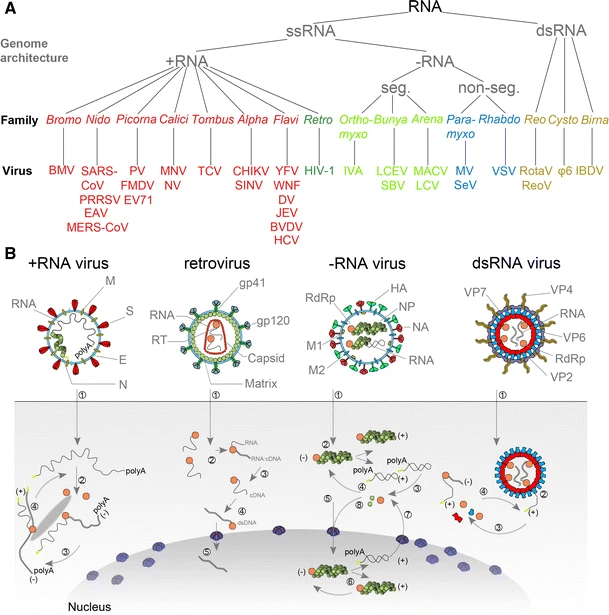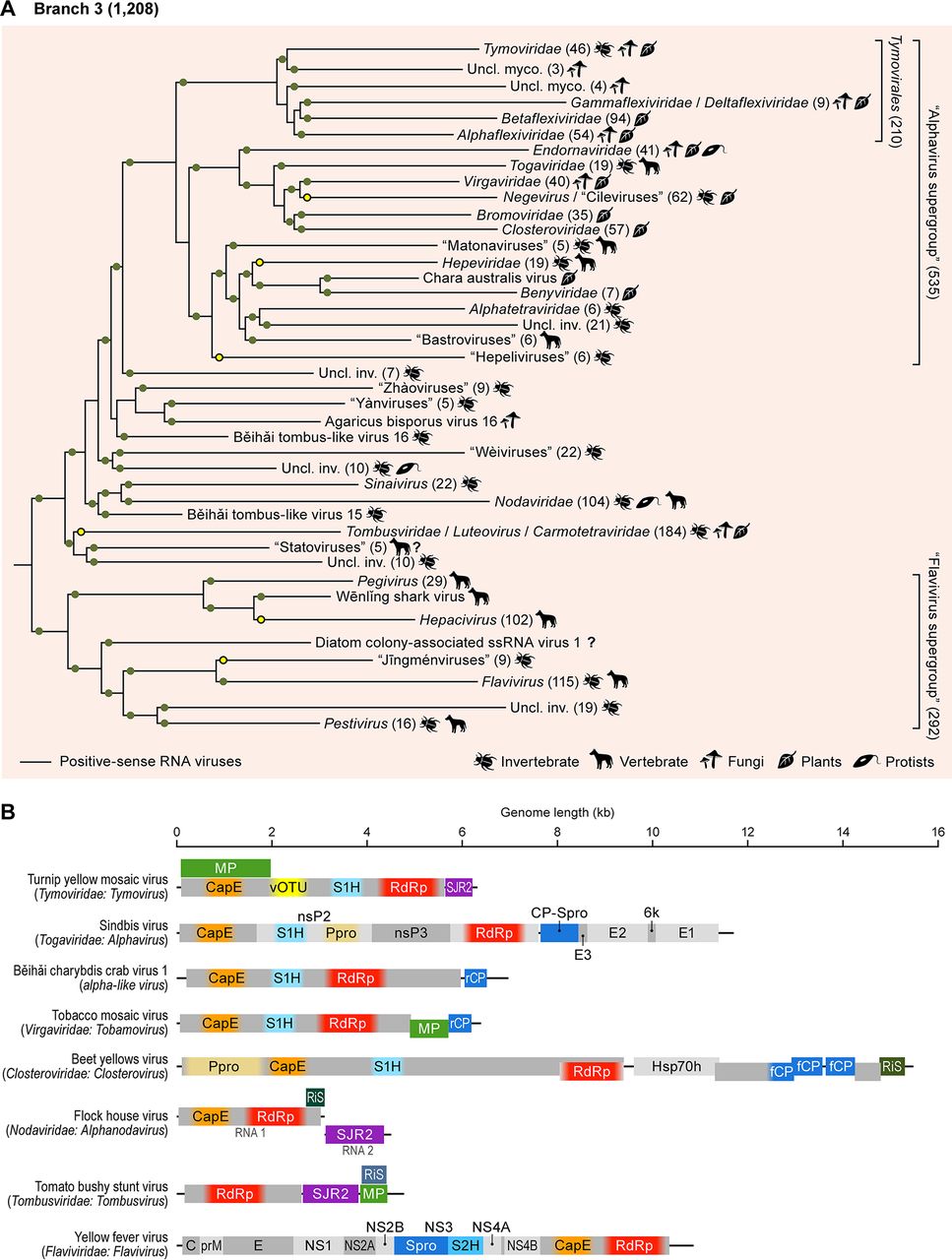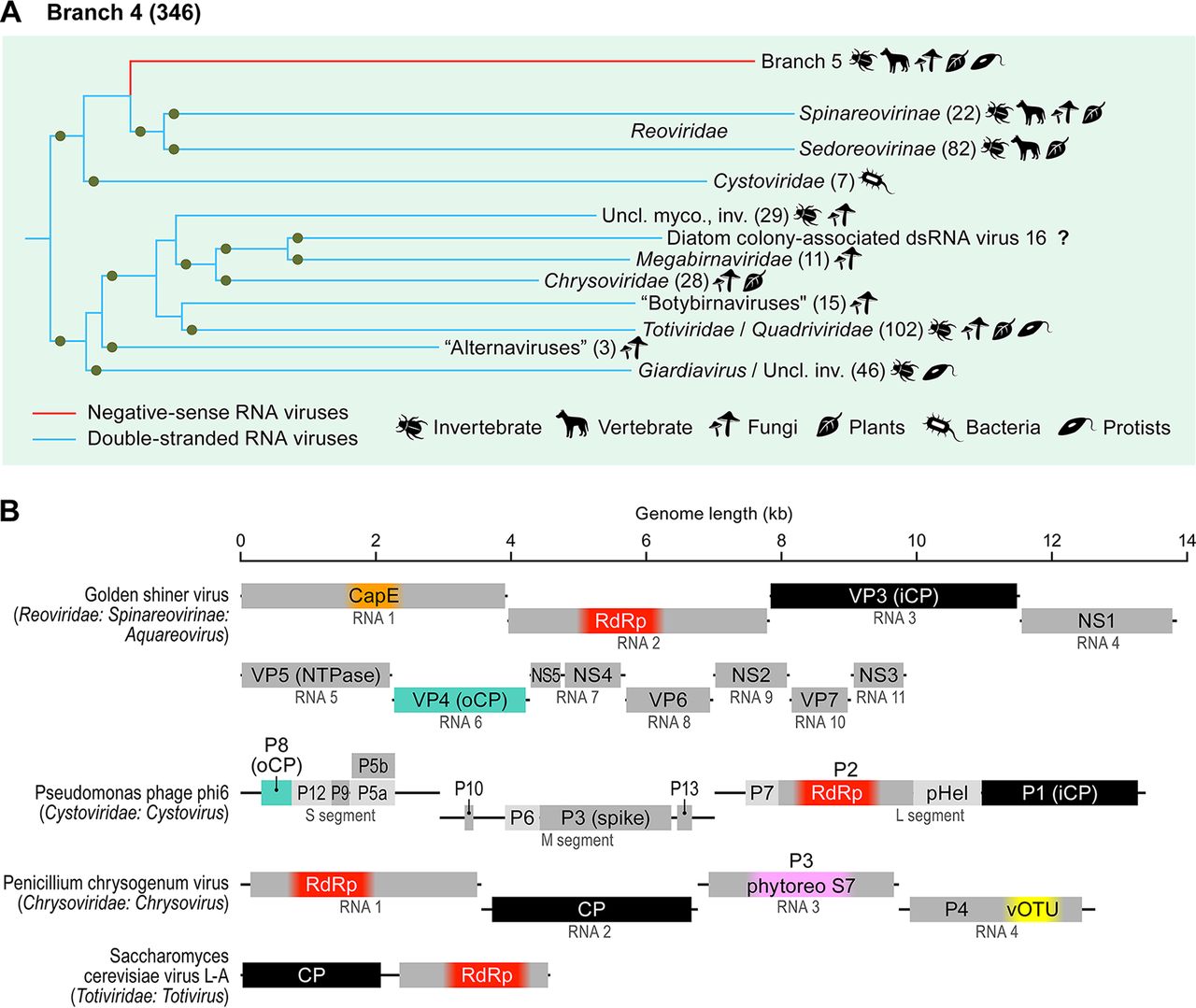|
Pisuviricota
''Pisuviricota'' is a phylum of RNA viruses that includes all positive-strand and double-stranded RNA viruses that infect eukaryotes and are not members of the phylum '' Kitrinoviricota,'' '' Lenarviricota'' or '' Duplornaviricota''. The name of the group is a syllabic abbreviation of “''pi''cornavirus ''su''pergroup” with the suffix ''-viricota'', indicating a virus phylum. Phylogenetic analyses suggest that '' Birnaviridae'' and ''Permutotetraviridae ''Permutotetraviridae'' is a family of viruses. Lepidopteran insects serve as natural hosts. The family contains one genus that has two species. Diseases associated with this family include: infection outcome varies from unapparent to lethal. ...'', both currently unassigned to a phylum in ''Orthornavirae'', also belong to this phylum and that both are sister groups. Another proposed family of the phylum is unassigned '' Polymycoviridae'' in ''Riboviria''.Suvi Sutela, Anna Poimala, Eeva J Vainio (2019)Viruses of fungi an ... [...More Info...] [...Related Items...] OR: [Wikipedia] [Google] [Baidu] |
Positive-strand RNA Virus
Positive-strand RNA viruses (+ssRNA viruses) are a group of related viruses that have Sense (molecular biology), positive-sense, single-stranded genomes made of ribonucleic acid. The positive-sense genome can act as messenger RNA (mRNA) and can be directly translation (biology), translated into viral proteins by the host cell, host cell's ribosomes. Positive-strand RNA viruses encode an RNA-dependent RNA polymerase (RdRp) which is used during replication of the genome to synthesize a negative-sense antigenome that is then used as a template to create a new positive-sense viral genome. Positive-strand RNA viruses are divided between the phyla ''Kitrinoviricota'', ''Lenarviricota'', and ''Pisuviricota'' (specifically classes ''Pisoniviricetes'' and ''Stelpaviricetes, Stelpavirictes'') all of which are in the kingdom ''Orthornavirae'' and Realm (virology), realm ''Riboviria''. They are Monophyly, monophyletic and descended from a common RNA virus ancestor. In the Baltimore classi ... [...More Info...] [...Related Items...] OR: [Wikipedia] [Google] [Baidu] |
Orthornavirae
''Orthornavirae'' is a kingdom of viruses that have genomes made of ribonucleic acid (RNA), including genes which encode an RNA-dependent RNA polymerase (RdRp). The RdRp is used to transcribe the viral RNA genome into messenger RNA (mRNA) and to replicate the genome. Viruses in this kingdom share a number of characteristics which promote rapid evolution, including high rates of genetic mutation, recombination, and reassortment. Viruses in ''Orthornavirae'' belong to the realm ''Riboviria''. They are descended from a common ancestor that may have been a non-viral molecule that encoded a reverse transcriptase instead of an RdRp for replication. The kingdom is subdivided into seven phyla that separate member viruses based on their genome type, host range, and genetic similarity. Viruses with three genome types are included: positive-strand RNA viruses, negative-strand RNA viruses, and double-stranded RNA viruses. Many of the most widely known viral diseases are caused by membe ... [...More Info...] [...Related Items...] OR: [Wikipedia] [Google] [Baidu] |
Double-stranded RNA Viruses
Double-stranded RNA viruses (dsRNA viruses) are a polyphyletic group of viruses that have double-stranded genomes made of ribonucleic acid. The double-stranded genome is used as a template by the viral RNA dependent RNA polymerase (RdRp) to transcribe a positive-strand RNA functioning as messenger RNA (mRNA) for the host cell's ribosomes, which translate it into viral proteins. The positive-strand RNA can also be replicated by the RdRp to create a new double-stranded viral genome. A distinguishing feature of the dsRNA viruses is their ability to carry out transcription of the dsRNA segments within the capsid, and the required enzymes are part of the virion structure. Double-stranded RNA viruses are classified into two phyla, '' Duplornaviricota'' and '' Pisuviricota'' (specifically class '' Duplopiviricetes''), in the kingdom '' Orthornavirae'' and realm ''Riboviria''. The two phyla do not share a common dsRNA virus ancestor, but evolved their double strands two separat ... [...More Info...] [...Related Items...] OR: [Wikipedia] [Google] [Baidu] |
Kitrinoviricota
''Kitrinoviricota'' is a phylum of RNA viruses that includes all positive-strand RNA viruses that infect eukaryotes The eukaryotes ( ) constitute the domain of Eukaryota or Eukarya, organisms whose cells have a membrane-bound nucleus. All animals, plants, fungi, seaweeds, and many unicellular organisms are eukaryotes. They constitute a major group of ... and are not members of the phylum '' Pisuviricota'' or '' Lenarviricota.'' The name of the group derives from Greek ''κίτρινος'' (''kítrinos''), which means yellow (a reference to yellow fever virus), and -''viricota'', which is the suffix for a virus phylum. Classes The following classes are recognized: * '' Alsuviricetes'' * '' Flasuviricetes'' * '' Magsaviricetes'' * '' Tolucaviricetes'' References Viruses {{Virus-stub ... [...More Info...] [...Related Items...] OR: [Wikipedia] [Google] [Baidu] |
Duplornaviricota
''Duplornaviricota'' is a phylum of RNA virus, RNA viruses, which contains all double-stranded RNA viruses, except for those in phylum ''Pisuviricota.'' Characteristic of the group is a Capsid, viral capsid composed of 60 homo- or heterodimers of capsid protein on a Capsid#Icosahedral, pseudo-T=2 lattice. Duplornaviruses infect both Prokaryote, prokaryotes and Eukaryote, eukaryotes. The name of the group derives from Italian ''duplo'' which means double (a reference to double-stranded), ''rna'' for the type of virus, and -''viricota'' which is the suffix for a Virus classification, virus phylum. Classes The following classes are recognized: * ''Chrymotiviricetes'' * ''Resentoviricetes'' * ''Vidaverviricetes'' References Viruses {{Virus-stub ... [...More Info...] [...Related Items...] OR: [Wikipedia] [Google] [Baidu] |
Stelpaviricetes
''Stelpaviricetes'' is a class of non-enveloped, positive-strand RNA viruses which infect plants and animals. Characteristic of the group is a VPg protein attached to the 5'-end of the genome and a conserved 3C- like protease from the PA clan of proteases for processing the translated polyprotein. The name of the group is a syllabic abbreviation An abbreviation () is a shortened form of a word or phrase, by any method including shortening, contraction, initialism (which includes acronym), or crasis. An abbreviation may be a shortened form of a word, usually ended with a trailing per ... of member orders "''stel''lavirales, ''pa''tatavirales" with the suffix ''-viricetes'' denoting a virus class. Orders The following orders are recognized: * '' Patatavirales'' * '' Stellavirales'' References Viruses {{Virus-stub ... [...More Info...] [...Related Items...] OR: [Wikipedia] [Google] [Baidu] |
Pisoniviricetes
''Pisoniviricetes'' is a class of positive-strand RNA viruses which infect eukaryotes. A characteristic of the group is a conserved 3C- like protease from the PA clan of proteases for processing the translated polyprotein. The name of the group is a portmanteau of member orders "''pi''cornavirales, ''so''belivirales, ''ni''dovirales" and -''viricetes'' which is the suffix for a virus class. Orders The following orders are recognized: * ''Nidovirales'' * ''Picornavirales ''Picornavirales'' is an order of viruses with vertebrate, invertebrate, protist and plant hosts. The name has a dual etymology. First, ''picorna-'' is an acronym for poliovirus, insensitivity to ether, coxsackievirus, orphan virus, rhinovirus, ...'' * '' Sobelivirales'' References Viruses {{Virus-stub ... [...More Info...] [...Related Items...] OR: [Wikipedia] [Google] [Baidu] |
Duplopiviricetes
''Durnavirales'' is an order of double-stranded RNA viruses which infect eukaryotes. The name of the group derives from Italian ''duplo'' which means double (a reference to double-stranded), ''rna'' for the type of virus, and -''virales'' which is the suffix for a virus order. Families The order contains the follow families: * '' Amalgaviridae'' * '' Curvulaviridae'' * '' Fusariviridae'' * ''Hypoviridae'' * ''Partitiviridae ''Partitiviridae'' is a family of double-stranded RNA viruses. Plants, fungi, and protozoa serve as natural hosts. It has been suggested that they can also infect bacteria. The name comes from the Latin ''partitius,'' which means divided, and ...'' * '' Picobirnaviridae'' * '' Soropartitiviridae'' References Viruses {{Virus-stub ... [...More Info...] [...Related Items...] OR: [Wikipedia] [Google] [Baidu] |
MBio
''mBio'' is a bimonthly peer-reviewed open access scientific journal published by the American Society for Microbiology in association with the American Society for Microbiology#American Academy of Microbiology, American Academy of Microbiology. It covers all aspects of the Microbiology, microbiological sciences, including virology, bacteriology, parasitology, mycology, and allied fields. The journal was established in 2010 with Arturo Casadevall as founding editor-in-chief. Abstracting and indexing The journal is abstracted and indexed in: According to the ''Journal Citation Reports'', the journal has a 2023 impact factor of 5.1. References External links * {{DEFAULTSORT:Mbio Microbiology journals Academic journals established in 2010 Bimonthly journals English-language journals American Society for Microbiology academic journals ... [...More Info...] [...Related Items...] OR: [Wikipedia] [Google] [Baidu] |
Permutotetraviridae
''Permutotetraviridae'' is a family of viruses. Lepidopteran insects serve as natural hosts. The family contains one genus that has two species. Diseases associated with this family include: infection outcome varies from unapparent to lethal. Taxonomy ''Permutotetraviridae'' has one genus which contains two species: * Genus: ''Alphapermutotetravirus'' ** ''Euprosterna elaeasa virus'' ** ''Thosea asigna virus'' Structure Viruses in ''Permutotetraviridae'' are non-enveloped, with icosahedral geometries, and T=4 symmetry. The diameter is around 40 nm. Genomes are linear, around 5.6kb in length. Life cycle Viral replication is cytoplasmic. Entry into the host cell is achieved by penetration into the host cell. Replication follows the positive stranded RNA virus replication model. Positive stranded RNA virus transcription is the method of transcription. Lepidopteran insectes serve as the natural host. Transmission routes are oral. References External links Viralzone: Pe ... [...More Info...] [...Related Items...] OR: [Wikipedia] [Google] [Baidu] |




